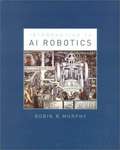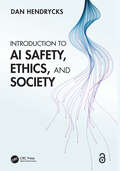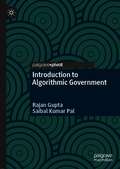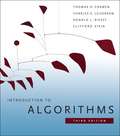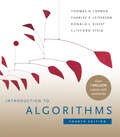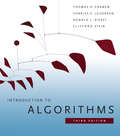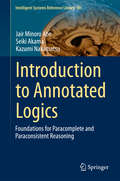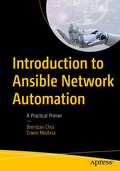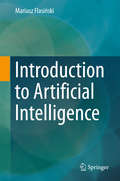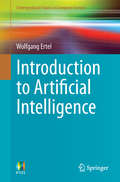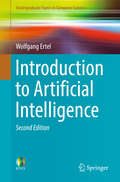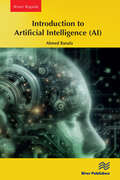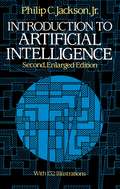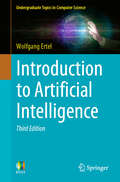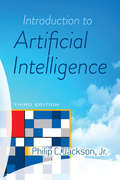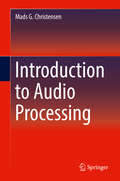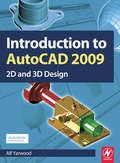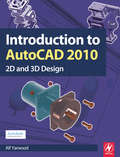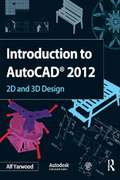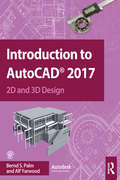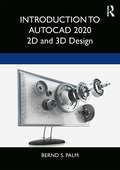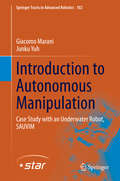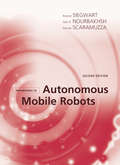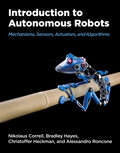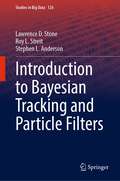- Table View
- List View
Introduction to AI Robotics
by Robin R. MurphyThis text covers all the material needed to understand the principles behind the AI approach to robotics and to program an artificially intelligent robot for applications involving sensing, navigation, planning, and uncertainty. Robin Murphy is extremely effective at combining theoretical and practical rigor with a light narrative touch. In the overview, for example, she touches upon anthropomorphic robots from classic films and science fiction stories before delving into the nuts and bolts of organizing intelligence in robots. Following the overview, Murphy contrasts AI and engineering approaches and discusses what she calls the three paradigms of AI robotics: hierarchical, reactive, and hybrid deliberative/reactive. Later chapters explore multiagent scenarios, navigation and path-planning for mobile robots, and the basics of computer vision and range sensing. Each chapter includes objectives, review questions, and exercises. Many chapters contain one or more case studies showing how the concepts were implemented on real robots. Murphy, who is well known for her classroom teaching, conveys the intellectual adventure of mastering complex theoretical and technical material.
Introduction to AI Safety, Ethics, and Society
by Dan HendrycksAs AI technology is rapidly progressing in capability and being adopted more widely across society, it is more important than ever to understand the potential risks AI may pose and how AI can be developed and deployed safely. Introduction to AI Safety, Ethics, and Society offers a comprehensive and accessible guide to this topic.This book explores a range of ways in which societies could fail to harness AI safely in coming years, such as malicious use, accidental failures, erosion of safety standards due to competition between AI developers or nation-states, and potential loss of control over autonomous systems. Grounded in the latest technical advances, this book offers a timely perspective on the challenges involved in making current AI systems safer. Ensuring that AI systems are safe is not just a problem for researchers in machine learning – it is a societal challenge that cuts across traditional disciplinary boundaries. Integrating insights from safety engineering, economics, and other relevant fields, this book provides readers with fundamental concepts to understand and manage AI risks more effectively.This is an invaluable resource for upper-level undergraduate and postgraduate students taking courses relating to AI Safety & Alignment, AI Ethics, AI Policy, and the Societal Impacts of AI, as well as anyone trying to better navigate the rapidly evolving landscape of AI safety.
Introduction to Algorithmic Government
by Rajan Gupta Saibal Kumar PalThe world is changing at a fast pace, so is the Government and Governance style. Humans are bound to go for Algorithmic strategies rather than manual or electronic ones in different domains. This book introduces the Algorithmic Government or Government by Algorithm, which refers to authorizing machines in the Public Sector for automated decision-making based on Artificial Intelligence, Data Science, and other technologies. It is an emerging concept introduced globally and will be considered revolutionary in the future. The book covers concepts, applications, progress status, and potential use-cases of Algorithmic Government. This book serves as introductory material for the readers from technology, public policy, administration, and management fields.
Introduction to Algorithms
by Clifford Stein Thomas H. Cormen Charles E. Leiserson Ronald L. RivestSome books on algorithms are rigorous but incomplete; others cover masses of material but lack rigor. Introduction to Algorithms uniquely combines rigor and comprehensiveness. The book covers a broad range of algorithms in depth, yet makes their design and analysis accessible to all levels of readers. Each chapter is relatively self-contained and can be used as a unit of study. The algorithms are described in English and in a pseudocode designed to be readable by anyone who has done a little programming. The explanations have been kept elementary without sacrificing depth of coverage or mathematical rigor.
Introduction to Algorithms, fourth edition
by Clifford Stein Thomas H. Cormen Charles E. Leiserson Ronald L. RivestA comprehensive update of the leading algorithms text, with new material on matchings in bipartite graphs, online algorithms, machine learning, and other topics.Some books on algorithms are rigorous but incomplete; others cover masses of material but lack rigor. Introduction to Algorithms uniquely combines rigor and comprehensiveness. It covers a broad range of algorithms in depth, yet makes their design and analysis accessible to all levels of readers, with self-contained chapters and algorithms in pseudocode. Since the publication of the first edition, Introduction to Algorithms has become the leading algorithms text in universities worldwide as well as the standard reference for professionals. This fourth edition has been updated throughout. New for the fourth edition • New chapters on matchings in bipartite graphs, online algorithms, and machine learning • New material on topics including solving recurrence equations, hash tables, potential functions, and suffix arrays • 140 new exercises and 22 new problems • Reader feedback–informed improvements to old problems • Clearer, more personal, and gender-neutral writing style • Color added to improve visual presentation • Notes, bibliography, and index updated to reflect developments in the field • Website with new supplementary material
Introduction to Algorithms, third edition (The\mit Press Ser.)
by Clifford Stein Thomas H. Cormen Charles E. Leiserson Ronald L. RivestThe latest edition of the essential text and professional reference, with substantial new material on such topics as vEB trees, multithreaded algorithms, dynamic programming, and edge-based flow.Some books on algorithms are rigorous but incomplete; others cover masses of material but lack rigor. Introduction to Algorithms uniquely combines rigor and comprehensiveness. The book covers a broad range of algorithms in depth, yet makes their design and analysis accessible to all levels of readers. Each chapter is relatively self-contained and can be used as a unit of study. The algorithms are described in English and in a pseudocode designed to be readable by anyone who has done a little programming. The explanations have been kept elementary without sacrificing depth of coverage or mathematical rigor.The first edition became a widely used text in universities worldwide as well as the standard reference for professionals. The second edition featured new chapters on the role of algorithms, probabilistic analysis and randomized algorithms, and linear programming. The third edition has been revised and updated throughout. It includes two completely new chapters, on van Emde Boas trees and multithreaded algorithms, substantial additions to the chapter on recurrence (now called “Divide-and-Conquer”), and an appendix on matrices. It features improved treatment of dynamic programming and greedy algorithms and a new notion of edge-based flow in the material on flow networks. Many exercises and problems have been added for this edition. The international paperback edition is no longer available; the hardcover is available worldwide.
Introduction to Annotated Logics
by Seiki Akama Jair Minoro Abe Kazumi NakamatsuThis book is written as an introduction to annotated logics. It provides logical foundations for annotated logics, discusses some interesting applications of these logics and also includes the authors' contributions to annotated logics. The central idea of the book is to show how annotated logic can be applied as a tool to solve problems of technology and of applied science. The book will be of interest to pure and applied logicians, philosophers and computer scientists as a monograph on a kind of paraconsistent logic. But, the layman will also take profit from its reading.
Introduction to Ansible Network Automation: A Practical Primer
by Brendan Choi Erwin MedinaThis book provides a comprehensive learning journey aimed at helping you master Ansible and efficiently automate a range of enterprise network devices, such as routers, switches, firewalls, Wireless LAN Controller (WLC), and Linux servers. Introduction to Ansible Network Automation combines the fundamentals of three books into one, covering basics of Linux administration, Ansible concepts, and Ansible network automation. Authors Brendan Choi and Erwin Medina have created a structured learning path that starts with the fundamentals and allows you to progressively enhance your skill sets with each chapter. Part I serves as an Ansible primer, guiding you through Linux basics using WSL on Windows 11 and assisting in the setup of your learning environment. Part II covers essential Ansible concepts through practical lab activities involving four Linux servers. In Part III, you will learn how to apply your Linux skills from Part I and the concepts from Part II to real-world scenarios by creating Ansible automation YAML scripts. What sets this book apart is its unique focus on Ansible and Network Automation, combined with a strong emphasis on understanding Linux. It is specifically designed for novice network automation engineers and students, assuming no prior Linux expertise, and provides first-hand experience starting from scratch. It also offers practical insights by sharing real-life examples of Ansible playbooks derived from production enterprise infrastructure, allowing you to gain an understanding of how Ansible can be effectively applied in real-world enterprise network environments. Upon completion of this book, you will have developed foundational skills in Ansible network automation and general Linux administration, and will understand how to apply this newly acquired knowledge to real-life scenarios. What You Will Learn Develop a comprehensive understanding of Ansible and its essential concepts for automating enterprise network devices and applying them to real-world scenariosMaster the basics of Ansible operations within Linux automation and progress to applying Ansible concepts specifically to network device automationExecute Ansible ad-hoc commands and playbooks for a range of network operational tasks, including configuration management, software and system updates, and upgradesWork with real-life examples of Ansible playbooks derived from actual enterprise infrastructure, gaining practical experience in writing Ansible YAML scriptsAcquire the skills to automate network operations using Ansible, streamline network management processes, and replace manual-driven tasks with directives in Ansible playbooks Who is This Book For Network, security, UC and systems engineers, as well as technical leaders, IT managers and network students.
Introduction to Artificial Intelligence
by Mariusz FlasińskiIn the chapters in Part I of this textbook the author introduces the fundamental ideas of artificial intelligence and computational intelligence. In Part II he explains key AI methods such as search, evolutionary computing, logic-based reasoning, knowledge representation, rule-based systems, pattern recognition, neural networks, and cognitive architectures. Finally, in Part III, he expands the context to discuss theories of intelligence in philosophy and psychology, key applications of AI systems, and the likely future of artificial intelligence. A key feature of the author's approach is historical and biographical footnotes, stressing the multidisciplinary character of the field and its pioneers. The book is appropriate for advanced undergraduate and graduate courses in computer science, engineering, and other applied sciences, and the appendices offer short formal, mathematical models and notes to support the reader.
Introduction to Artificial Intelligence
by Wolfgang Ertel Nathanael T. BlackThis concise and accessible textbook supports a foundation or module course on A.I., covering a broad selection of the subdisciplines within this field. The book presents concrete algorithms and applications in the areas of agents, logic, search, reasoning under uncertainty, machine learning, neural networks and reinforcement learning. Topics and features: presents an application-focused and hands-on approach to learning the subject; provides study exercises of varying degrees of difficulty at the end of each chapter, with solutions given at the end of the book; supports the text with highlighted examples, definitions, and theorems; includes chapters on predicate logic, PROLOG, heuristic search, probabilistic reasoning, machine learning and data mining, neural networks and reinforcement learning; contains an extensive bibliography for deeper reading on further topics; supplies additional teaching resources, including lecture slides and training data for learning algorithms, at an associated website.
Introduction to Artificial Intelligence
by Wolfgang ErtelThis accessible and engaging textbook presents a concise introduction to the exciting field of artificial intelligence (AI). The broad-ranging discussion covers the key subdisciplines within the field, describing practical algorithms and concrete applications in the areas of agents, logic, search, reasoning under uncertainty, machine learning, neural networks, and reinforcement learning. Fully revised and updated, this much-anticipated second edition also includes new material on deep learning. Topics and features: presents an application-focused and hands-on approach to learning, with supplementary teaching resources provided at an associated website; contains numerous study exercises and solutions, highlighted examples, definitions, theorems, and illustrative cartoons; includes chapters on predicate logic, PROLOG, heuristic search, probabilistic reasoning, machine learning and data mining, neural networks and reinforcement learning; reports on developments in deep learning, including applications of neural networks to generate creative content such as text, music and art (NEW); examines performance evaluation of clustering algorithms, and presents two practical examples explaining Bayes' theorem and its relevance in everyday life (NEW); discusses search algorithms, analyzing the cycle check, explaining route planning for car navigation systems, and introducing Monte Carlo Tree Search (NEW); includes a section in the introduction on AI and society, discussing the implications of AI on topics such as employment and transportation (NEW). Ideal for foundation courses or modules on AI, this easy-to-read textbook offers an excellent overview of the field for students of computer science and other technical disciplines, requiring no more than a high-school level of knowledge of mathematics to understand the material.
Introduction to Artificial Intelligence (AI)
by Ahmed BanafaIntroduction to Artificial Intelligence (AI) provides a comprehensive overview of the latest trends in artificial intelligence. The book covers the state of the art in AI research, including machine learning, natural language processing, computer vision, and robotics.The book offers a forward-looking perspective on the future of AI, exploring the emerging trends and applications that are likely to shape the next decade of AI innovation. It also provides practical guidance for businesses and individuals on how to leverage the power of AI to create new products, services, and opportunities.Overall, the book is an essential read for anyone who wants to stay ahead of the curve in the rapidly evolving field of AI and understand the impact that this transformative technology will have on our lives in the coming years.
Introduction to Artificial Intelligence (Dover Books on Mathematics)
by Philip C. Jackson Jr.Can computers think? Can they use reason to develop their own concepts, solve complex problems, play games, understand our languages? This comprehensive survey of artificial intelligence ― the study of how computers can be made to act intelligently ― explores these and other fascinating questions. Introduction to Artificial Intelligence presents an introduction to the science of reasoning processes in computers, and the research approaches and results of the past two decades. You'll find lucid, easy-to-read coverage of problem-solving methods, representation and models, game playing, automated understanding of natural languages, heuristic search theory, robot systems, heuristic scene analysis and specific artificial-intelligence accomplishments. Related subjects are also included: predicate-calculus theorem proving, machine architecture, psychological simulation, automatic programming, novel software techniques, industrial automation and much more.A supplementary section updates the original book with major research from the decade 1974-1984. Abundant illustrations, diagrams and photographs enhance the text, and challenging practice exercises at the end of each chapter test the student's grasp of each subject.The combination of introductory and advanced material makes Introduction to Artificial Intelligence ideal for both the layman and the student of mathematics and computer science. For anyone interested in the nature of thought, it will inspire visions of what computer technology might produce tomorrow.
Introduction to Artificial Intelligence (Undergraduate Topics in Computer Science)
by Wolfgang ErtelThis accessible and engaging textbook presents a concise introduction to the exciting field of artificial intelligence (AI). The broad-ranging discussion covers the key subdisciplines within the field, describing practical algorithms and concrete applications in the areas of agents, logic, search, reasoning under uncertainty, machine learning, neural networks, and reinforcement learning. Fully revised and updated, this much-anticipated third edition also includes new material on deep learning.Topics and features:· Presents an application-focused and hands-on approach to learning, with supplementary teaching resources provided at an associated website · Introduces convolutional neural networks as the currently most important type of deep learning networks with applications to image classification (NEW) · Contains numerous study exercises and solutions, highlighted examples, definitions, theorems, and illustrative cartoons · Reports on developments in deep learning, including applications of neural networks to large language models as used in state-of-the-art chatbots as well as to the generation of music and art (NEW) · Includes chapters on predicate logic, PROLOG, heuristic search, probabilistic reasoning, machine learning and data mining, neural networks, and reinforcement learning · Covers various classical machine learning algorithms and introduces important general concepts such as cross validation, data normalization, performance metrics and data augmentation (NEW)· Includes a section on AI and society, discussing the implications of AI on topics such as employment and transportation Ideal for foundation courses or modules on AI, this easy-to-read textbook offers an excellent overview of the field for students of computer science and other technical disciplines, requiring no more than a high-school level of knowledge of mathematics to understand the material.Dr. Wolfgang Ertel is a professor at the Institute for Artificial Intelligence at the Ravensburg-Weingarten University of Applied Sciences, Germany.
Introduction to Artificial Intelligence: Third Edition (Dover Books On Mathematics Ser.)
by Philip C. JacksonCan computers think? Can they use reason to develop their own concepts, solve complex problems, understand our languages? This updated edition of a comprehensive survey includes extensive new text on "Artificial Intelligence in the 21st Century," introducing deep neural networks, conceptual graphs, languages of thought, mental models, metacognition, economic prospects, and research toward human-level AI.Ideal for both lay readers and students of computer science, the original text features abundant illustrations, diagrams, and photographs as well as challenging exercises. Lucid, easy-to-read discussions examine problem-solving methods and representations, game playing, automated understanding of natural languages, heuristic search theory, robot systems, heuristic scene analysis, predicate-calculus theorem proving, automatic programming, and many other topics.
Introduction to Audio Processing
by Mads G. ChristensenThis textbook presents an introduction to signal processing for audio applications. The author’s approach posits that math is at the heart of audio processing and that it should not be simplified. He thus retains math as the core of signal processing and includes concepts of difference equations, convolution, and the Fourier Transform. Each of these is presented in a context where they make sense to the student and can readily be applied to build artifacts. Each chapter in the book builds on the previous ones, building a linear, coherent story. The book starts with a definition of sound and goes on to discuss digital audio signals, filters, The Fourier Transform, audio effects, spatial effects, audio equalizers, dynamic range control, and pitch estimation. The exercises in each chapter cover the application of the concepts to audio signals. The exercises are made specifically for Pure Data (Pd) although traditional software, such as MATLAB, can be used. The book is intended for students in media technology bachelor programs. The book is based on material the author developed teaching on the topic over a number of years.
Introduction to AutoCAD 2009
by Alf YarwoodAlf Yarwood provides a practical, structured course of work matched to the latest release of AutoCAD. After introducing first principles and the creation of 2D technical drawings, he goes on to demonstrate the construction of 3D solid and surface model drawings and rendering. All the new features of the 2009 software release are taken into account and the increasing emphasis on 3D solid modelling in the software is reflected in the book. The 2D chapters are also suitable for those learning how to use AutoCAD LT 2009.Suitable for all new users of AutoCAD, this book is particularly applicable to vocational and introductory level undergraduate courses in engineering and construction. It is an ideal textbook for the City & Guilds Computer Aided Design and Engineering qualifications (4353 and 2303)and the relevant CAD units of BTEC National and BTEC Higher National Engineering and Construction schemes from Edexcel.A free companion website is available at http://books.elsevier.com/companions/9780750689830 and features: Worked solutions and AutoCAD drawing files of stages and results for the exercises in the bookFurther exercises and multiple-choice questions with answers.
Introduction to AutoCAD 2010
by Alf YarwoodAlf Yarwood provides a practical, structured course of work matched to the latest release of AutoCAD. After introducing first principles and the creation of 2D technical drawings, he goes on to demonstrate the construction of 3D solid drawings, surface model drawings and rendering. All the new features of the 2010 software release are taken into account and the increasing emphasis on 3D solid modelling in the software is reflected in the book. The 2D chapters are also suitable for those learning how to use AutoCAD LT 2010.Suitable for all new users of AutoCAD, this book is particularly applicable to vocational and introductory level undergraduate courses in engineering and construction. Further Education students in the UK will find this an ideal textbook to cater for the City & Guilds 4353 and 2303 qualifications and the relevant CAD units of BTEC National and BTEC Higher National Engineering and Construction schemes from Edexcel. Many Foundation Degrees also contain CAD modules for which this book can be of use.Readers will also be able to visit a free companion website at http://books.elsevier.com/companions/9781856178686, where they will find worked solutions and AutoCAD drawing files of stages and results for the exercises in the book, as well as further exercises and multiple-choice questions with answers.
Introduction to AutoCAD 2012
by Alf YarwoodMaster the complexities of the world’s bestselling 2D and 3D software with Alf Yarwood’s new Introduction to AutoCAD 2012. Ideally suited to new users of AutoCAD, this book will be a useful resource for drawing modules in both vocational and introductory undergraduate courses in engineering and construction.Alf Yarwood has once again produced a comprehensive, step-by-step introduction to the latest release of AutoCAD. Covering all the basic principles and acting as an introduction to 2D drawing, it also contains extensive coverage of all 3D topics, including 3D solid modelling and rendering.A fold-out list of frequently used keyboard shortcuts will help you perform actions quickly while working through the book, and an appendix of ribbon references clearly describes all the software tools that are used throughout the book.Further education students in the UK will find this an invaluable textbook for City and Guilds AutoCAD qualifications as well as the relevant Computer Aided Drawing units of BTEC National Engineering, Higher National Engineering and Construction courses from Edexcel. Students enrolled in Foundation Degree courses containing CAD modules will also find this a very useful reference and learning aid.Readers will also be able to visit a free companion website at:www.introtoautocad2012.com where they will find worked solutions and AutoCAD drawing files of stages, and results for the exercises in this book, as well as further exercises and multiple-choice questions with answers.
Introduction to AutoCAD 2017: 2D and 3D Design
by Alf Yarwood Bernd S. PalmMaster the complexities of the world's bestselling 2D and 3D software with Introduction to AutoCAD 2017. Ideally suited to new users of AutoCAD, this book will be a useful resource for drawing modules in both vocational and introductory undergraduate courses in engineering and construction. A comprehensive, step-by-step introduction to the latest release of AutoCAD. Covering all the basic principles and acting as an introduction to 2D drawing, it also contains extensive coverage of all 3D topics, including 3D solid modelling and rendering. Written by a member of the Autodesk Developer Network. Hundreds of colour pictures, screenshots and diagrams illustrate every stage of the design process. Worked examples and exercises provide plenty of practice material to build proficiency with the software. Further education students will find this an invaluable textbook for City & Guilds AutoCAD qualifications as well as the relevant Computer Aided Drawing units of BTEC National Engineering, Higher National Engineering and Construction courses from Edexcel. Students enrolled in Foundation Degree courses containing CAD modules will also find this a very useful reference and learning aid.
Introduction to AutoCAD 2020: 2D and 3D Design
by Bernd S. PalmMaster the complexities of the world's bestselling 2D and 3D software with Introduction to AutoCAD 2020. Ideally suited to new users, and relevant for both AutoCAD 2020 and AutoCAD 2021, this book will be a useful resource for drawing modules in both vocational and introductory undergraduate courses in engineering and construction. Experienced users will also find the updated images, commands and software information to be essential reading in order to adapt to the latest AutoCAD interface. A comprehensive, step-by-step introduction to the latest release of AutoCAD. Covering all the basic principles and acting as an introduction to 2D drawing, it also contains extensive coverage of all 3D topics, including 3D solid modelling and rendering. Written by a member of the Autodesk Developer Network. Hundreds of colour pictures, screenshots and diagrams illustrate every stage of the design process. Worked examples and exercises provide plenty of practice material to build proficiency with the software. Further education students will find this an invaluable textbook for City & Guilds AutoCAD qualifications as well as the relevant Computer Aided Drawing units of BTEC National Engineering, Higher National Engineering and Construction courses from Edexcel. Students enrolled in Foundation Degree courses containing CAD modules will also find this a very useful reference and learning aid.
Introduction to Autonomous Manipulation
by Giacomo Marani Junku Yuh"Autonomous manipulation" is a challenge in robotic technologies. It refers to the capability of a mobile robot system with one or more manipulators that performs intervention tasks requiring physical contacts in unstructured environments and without continuous human supervision. Achieving autonomous manipulation capability is a quantum leap in robotic technologies as it is currently beyond the state of the art in robotics. This book addresses issues with the complexity of the problems encountered in autonomous manipulation including representation and modeling of robotic structures, kinematic and dynamic robotic control, kinematic and algorithmic singularity avoidance, dynamic task priority, workspace optimization and environment perception. Further development in autonomous manipulation should be able to provide robust improvements of the solutions for all of the above issues. The book provides an extensive tract on sensory-based autonomous manipulation for intervention tasks in unstructured environments. After presenting the theoretical foundations for kinematic and dynamic modelling as well as task-priority based kinematic control of multi-body systems, the work is focused on one of the most advanced underwater vehicle-manipulator system, SAUVIM (Semi-Autonomous Underwater Vehicle for Intervention Missions). Solutions to the problem of target identification and localization are proposed, a number of significant case studies are discussed and practical examples an d experimental/simulation results are presented. The book may inspire the robot research community to further investigate critical issues in autonomous manipulation and to develop robot systems that can profoundly impact our society for the better.
Introduction to Autonomous Mobile Robots, second edition (Intelligent Robotics and Autonomous Agents series)
by Roland Siegwart Illah Reza Nourbakhsh Davide ScaramuzzaThe second edition of a comprehensive introduction to all aspects of mobile robotics, from algorithms to mechanisms.Mobile robots range from the Mars Pathfinder mission's teleoperated Sojourner to the cleaning robots in the Paris Metro. This text offers students and other interested readers an introduction to the fundamentals of mobile robotics, spanning the mechanical, motor, sensory, perceptual, and cognitive layers the field comprises. The text focuses on mobility itself, offering an overview of the mechanisms that allow a mobile robot to move through a real world environment to perform its tasks, including locomotion, sensing, localization, and motion planning. It synthesizes material from such fields as kinematics, control theory, signal analysis, computer vision, information theory, artificial intelligence, and probability theory. The book presents the techniques and technology that enable mobility in a series of interacting modules. Each chapter treats a different aspect of mobility, as the book moves from low-level to high-level details. It covers all aspects of mobile robotics, including software and hardware design considerations, related technologies, and algorithmic techniques.This second edition has been revised and updated throughout, with 130 pages of new material on such topics as locomotion, perception, localization, and planning and navigation. Problem sets have been added at the end of each chapter. Bringing together all aspects of mobile robotics into one volume, Introduction to Autonomous Mobile Robots can serve as a textbook or a working tool for beginning practitioners.Curriculum developed by Dr. Robert King, Colorado School of Mines, and Dr. James Conrad, University of North Carolina-Charlotte, to accompany the National Instruments LabVIEW Robotics Starter Kit, are available. Included are 13 (6 by Dr. King and 7 by Dr. Conrad) laboratory exercises for using the LabVIEW Robotics Starter Kit to teach mobile robotics concepts.
Introduction to Autonomous Robots: Mechanisms, Sensors, Actuators, and Algorithms
by Nikolaus Correll Bradley Hayes Christoffer Heckman Alessandro RonconeA comprehensive introduction to the field of autonomous robotics aimed at upper-level undergraduates and offering additional online resources.Textbooks that provide a broad algorithmic perspective on the mechanics and dynamics of robots almost unfailingly serve students at the graduate level. Introduction to Autonomous Robots offers a much-needed resource for teaching third- and fourth-year undergraduates the computational fundamentals behind the design and control of autonomous robots. The authors use a class-tested and accessible approach to present progressive, step-by-step development concepts, alongside a wide range of real-world examples and fundamental concepts in mechanisms, sensing and actuation, computation, and uncertainty. Throughout, the authors balance the impact of hardware (mechanism, sensor, actuator) and software (algorithms) in teaching robot autonomy. Features:Rigorous and tested in the classroomWritten for engineering and computer science undergraduates with a sophomore-level understanding of linear algebra, probability theory, trigonometry, and statisticsQR codes in the text guide readers to online lecture videos and animationsTopics include: basic concepts in robotic mechanisms like locomotion and grasping, plus the resulting forces; operation principles of sensors and actuators; basic algorithms for vision and feature detection; an introduction to artificial neural networks, including convolutional and recurrent variantsExtensive appendices focus on project-based curricula, pertinent areas of mathematics, backpropagation, writing a research paper, and other topicsA growing library of exercises in an open-source, platform-independent simulation (Webots)
Introduction to Bayesian Tracking and Particle Filters (Studies in Big Data #126)
by Roy L. Streit Lawrence D. Stone Stephen L. AndersonThis book provides a quick but insightful introduction to Bayesian tracking and particle filtering for a person who has some background in probability and statistics and wishes to learn the basics of single-target tracking. It also introduces the reader to multiple target tracking by presenting useful approximate methods that are easy to implement compared to full-blown multiple target trackers.The book presents the basic concepts of Bayesian inference and demonstrates the power of the Bayesian method through numerous applications of particle filters to tracking and smoothing problems. It emphasizes target motion models that incorporate knowledge about the target’s behavior in a natural fashion rather than assumptions made for mathematical convenience.The background provided by this book allows a person to quickly become a productive member of a project team using Bayesian filtering and to develop new methods and techniques for problems the team may face.
